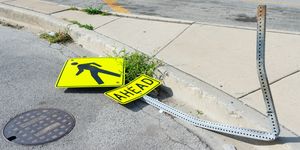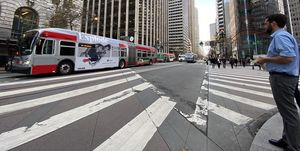- Luxembourg, one of the smallest countries in Europe, has gone fare-free with its public transit to alleviate congestion and environmental concerns.
- It is the first country to make all public transit free of charge, a move that is becoming increasingly popular in cities in the U.S.
- If the program is successful in moving people from private cars to public transit, those who want to drive will be able to commute on less crowded roads.
Although it’s popular there, you don’t have to look as far as Europe to see efforts to reduce commuter-car congestion in cities. Across the United States, too, cities are taking measures to have fewer cars on their roads—and not without reason. Pedestrian deaths, which occur largely in cities, are at levels not seen in over 30 years. Climate change is receiving increasing attention, and personal transportation contributes to that. And congestion in cities is the highest it has ever been. Even the most pro-car among us (and we count ourselves in that number) realize that daily traffic snarls are no good for anybody.
Increasing public transportation use is largely regarded as one way to alleviate the strains put on cities by private cars, and Luxembourg is taking an unprecedented step to reduce car use in the country. Starting this week, all forms of public transportation, including trains and buses, are free in the country of 602,000. The plan was originally announced last March.
The goal is to reduce traffic congestion and emissions, Dany Frank, a spokesperson for the Ministry of Mobility and Public Works, told CNN. Luxembourg has the highest rate of car ownership in Europe, at 670 cars per 1000 people in 2017. As of 2015, the U.S. number was 756 cars per 1000 people.
According to EU data, each driver in Luxembourg spends an average of 30 hours stuck in traffic each year, also one of the highest rates in Europe (on the other hand, in 2017, drivers in the U.S. saw an average delay of 54 hours over the year). A big culprit of the traffic is the large number of people who commute into Luxembourg City every day, roughly 200,000, as a result of the high cost of living in the city.
Now with public transportation free in the country, the government hopes that a large number of people will stop commuting in cars. The idea isn’t unique to Luxembourg or even Europe; U.S. cities have been taking similar action as they hope to boost public transit ridership.
The City Council of Kansas City, Missouri—a city of about 490,000—voted last month to make the city’s bus system free. Kansas City’s streetcar, which went into service in 2016, is already free, which is what some people attribute its success to. The move has also been pitched as a way to make it easier for low-income residents to get to work.
Several sports teams in the U.S. offer free public transit to get to games, including the Phoenix Suns, the San Francisco Golden State Warriors, and the yet-to-be-named future NHL team in Seattle.
Beginning this year, the bus service in Olympia, Washington, was made free after the city’s Intercity Transit recognized that it would be cheaper than replacing outdated fare-collection boxes with new electronic machines.
Public transit becoming free has been met with various levels of success. When Corvallis, Oregon, decided that it would make its bus system free back in 2011, it saw ridership increase by nearly 38 percent. In October 2018, Dunkirk, France, made its buses free, and a year later a study found that ridership increased 65 percent during the week and 125 percent on the weekend, in addition helping cut private-car use.
Nonetheless, when several U.S. cities including Denver, Colorado, and Trenton, New Jersey, experimented with making their bus systems fare-free in the 1970s, the results were mixed. Ridership jumped 15 percent, but there was no notable impact on traffic patterns; fares were later reintroduced. In 2013, the capital of Estonia, Tallinn, made all public transit free, and a study of the impacts found that going fare-free resulted in a 1.2 percent increase in ridership, but the small increase was attributed to fares already being low and ridership was high before the program was implemented.
As cities look to getting people out of cars, making public transit free is increasingly seen as a solution. Although Luxembourg is one of the smallest countries in Europe, the results of the decision to go fare-free will stand as an example to other cities and countries considering the idea, especially in its level of success for reducing congestion.
Source: Motor - aranddriver.com






